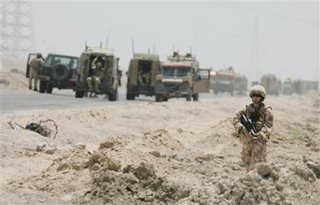 Famously, in the days when we had a nationalised railway network and the system was routinely brought to a grinding halt with the even moderate winter snows, a hapless executive was hauled before the cameras to explain why, on one particular occasion, a particularly light fall of snow had brought trains to a complete halt.
Famously, in the days when we had a nationalised railway network and the system was routinely brought to a grinding halt with the even moderate winter snows, a hapless executive was hauled before the cameras to explain why, on one particular occasion, a particularly light fall of snow had brought trains to a complete halt.It was, he explained to the incredulous media, "the wrong kind of snow". This he later expanded upon, telling us that it has been a very fine snow which, while not heavy enough to block the lines, had invaded the engines, blocking filters and shorting out electrics. This was plausible enough but too late. Forever in the vocabulary now rests that sneering commentary on the inadequacies of nationalised industries, "…the wrong kind of snow".
Reviewing now the recent performance of the Israelis in the Lebanon campaign – something which I promised in a post a week ago, I suppose the best that can be said of it is that the IDF was fighting "the wrong kind of war".
 What brought this to mind was a photograph in today's edition of The Sunday Telegraph which we published on this blog nearly a month ago (so much for blogs being "derivative"), which illustrates a different facet of precisely the problem which the Israelis currently face (above left).
What brought this to mind was a photograph in today's edition of The Sunday Telegraph which we published on this blog nearly a month ago (so much for blogs being "derivative"), which illustrates a different facet of precisely the problem which the Israelis currently face (above left).In the instance illustrated by the photograph and the accompanying story we have an issue rehearsed at length (and in depth) by this blog, where we argue that British troops attempting to police southern Iraq are dangerously ill-equipped.
More specifically, we have an army in theatre relying on equipment such as the Challenger Main Battle Tank (MBT) (pictured above, on patrol in Al Amarah, southern Iraq) and the Warrior Mechanised Infantry Combat Vehicle (MICV) which were devised as the core weapons of armoured divisions intended to combat a massed Warsaw Pact armoured thrust in northern Europe. In short, they were never intended for counter-insurgency operations (especially in the high temperatures of the Iraqi theatre) and are wholly unsuited to it.
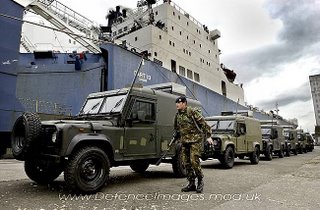 Partly recognising this, in late 2003, the British Ministry of Defence drafted in a consignment of mothballed armoured Land Rovers (the nearest equivalent to the up-armoured Humvee), themselves designed for dealing with street violence in Belfast and other Northern Ireland locations, during the height of the "troubles".
Partly recognising this, in late 2003, the British Ministry of Defence drafted in a consignment of mothballed armoured Land Rovers (the nearest equivalent to the up-armoured Humvee), themselves designed for dealing with street violence in Belfast and other Northern Ireland locations, during the height of the "troubles". Known universally as "Snatch" Land Rovers, these might have been adequate for dealing with the provisional IRA and general street violence but against an enemy which had access to any number of munitions and increasingly sophisticated roadside bombs – such as the explosively formed projectile (EFP) roadside mine – they proved easy prey. Thus it was that, by early this year, soldiers patrolling in "Snatch" Land Rovers had accounted for more than a quarter of our combat deaths in Iraq.
Known universally as "Snatch" Land Rovers, these might have been adequate for dealing with the provisional IRA and general street violence but against an enemy which had access to any number of munitions and increasingly sophisticated roadside bombs – such as the explosively formed projectile (EFP) roadside mine – they proved easy prey. Thus it was that, by early this year, soldiers patrolling in "Snatch" Land Rovers had accounted for more than a quarter of our combat deaths in Iraq.This was a problem which has also faced the US forces, which have suffered a higher proportion of casualties and larger absolute numbers from what are generically known as Improvised Explosive Devices or IEDs.
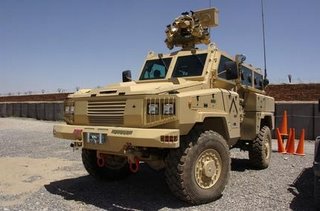 In response to that – after a series of false starts, which included a programme of adding armour to the standard utility vehicle, the Humvee – the US, led by the US Marine Corps, started a re-equipment programme using vehicles based on Rhodesian and South African experience, specifically designed to deal with the IED threat. These include the RG-31, the Cougar and the Buffalo.
In response to that – after a series of false starts, which included a programme of adding armour to the standard utility vehicle, the Humvee – the US, led by the US Marine Corps, started a re-equipment programme using vehicles based on Rhodesian and South African experience, specifically designed to deal with the IED threat. These include the RG-31, the Cougar and the Buffalo.Less obviously but just as significant, the US forces are undergoing a fundamental restructuring. In the war against the hit and run bomber, who will fight in civilian clothes and merge with the civilian population, there is no front line. Casualty rates amongst non-combatants (known from Vietnam days as REMFs) have matched those in combat units.
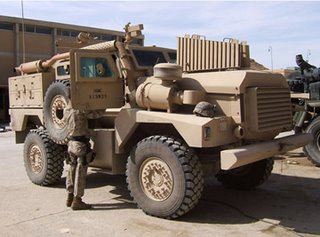 Thus, in this type of war, the spearhead troops are no longer the infantry and the tankers but the combat engineers. Numbers of these troops in the US order of battle have been increased substantially and, using their new RG-31s and other equipment, they have been active in hunting out IEDs. As a result, they are most often at the sharp end in the vicious fire-fights that develop when insurgents ambush the bomb hunters.
Thus, in this type of war, the spearhead troops are no longer the infantry and the tankers but the combat engineers. Numbers of these troops in the US order of battle have been increased substantially and, using their new RG-31s and other equipment, they have been active in hunting out IEDs. As a result, they are most often at the sharp end in the vicious fire-fights that develop when insurgents ambush the bomb hunters.In Lebanon, the problem confronting the IDF was much the same – the hit-and-run fighter in civilian clothes – but the weapons employed by the enemy differed. In Iraqi desert conditions, where there is often little cover and most of the roads are metalled, the roadside bomb is the weapon of choice. In Afghanistan, where cover is also sparse in some areas, but many more of the roads are unmetalled, the mine is commonly used. But in south Lebanon, where the topography is in places more similar to the rolling, verdant hills of Gloucestershire and Somerset (not for nothing is the area known as "Little England"), the man-portable anti-tank weapon comes into its own.
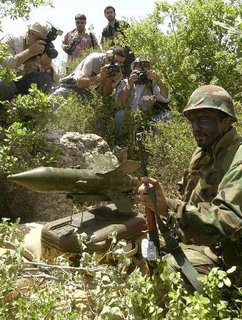 With thick cover, or the protection and disguise of civilian villages, small teams using RPG-7s, or the fearsome RPG-29, anti-tank teams can wreak havoc with armoured formations in what is nightmare country for tankers. Hezbolla have even been pressing into service Russian-made "Sagger" wire-guided missiles – which caused such great slaughter of Israeli tanks during the Yom Kippur war – and even captured (or purchased) US TOW missiles.
With thick cover, or the protection and disguise of civilian villages, small teams using RPG-7s, or the fearsome RPG-29, anti-tank teams can wreak havoc with armoured formations in what is nightmare country for tankers. Hezbolla have even been pressing into service Russian-made "Sagger" wire-guided missiles – which caused such great slaughter of Israeli tanks during the Yom Kippur war – and even captured (or purchased) US TOW missiles. Combined with roadside bombs – some disguised as boulders, copying techniques pioneered by Iraqis, who have been known to cast their bombs into kerbstones) – these make a thing of the past, rapid armoured thrusts of the type that so thrilled us during the 1967 Six Day War, and the inspired counter-thrust over the Canal during Yom Kippur.
Instead, like the Americans have learnt to do, and the British are now following with a batch of Cougars on order, the Israelis have had to "up-armour" their engineers, on whom they rely for route clearing before what are now considered "conventional" armoured forces can be deployed. Thus did we see the widespread use of the Puma in the first, cautious phases of the ground campaign.
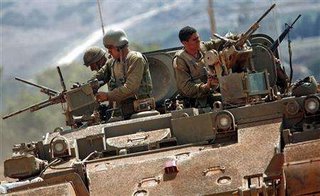 These vehicles, deployed by combat engineers, are little more than turretless Centurion Main Battle Tanks, known as the Poretz Mokshim Handasati (minefield breakthrough vehicle). Although better than nothing, they are far from ideal, not least because they lack the essential attribute of an armoured personnel carrier – a rear exit door. Egressing troops are forced to clamber over the hull, exposing themselves to fire.
These vehicles, deployed by combat engineers, are little more than turretless Centurion Main Battle Tanks, known as the Poretz Mokshim Handasati (minefield breakthrough vehicle). Although better than nothing, they are far from ideal, not least because they lack the essential attribute of an armoured personnel carrier – a rear exit door. Egressing troops are forced to clamber over the hull, exposing themselves to fire.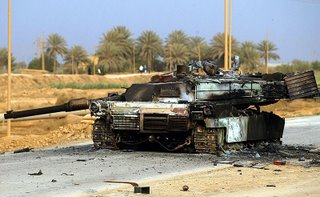 Furthermore, as US forces have found – and as will the British – up-armouring invites a version of the arms race, where the terrorists use heavier and more sophisticated weapons, to the extent that not even the US 65-ton Abrams Main Battle Tank is immune from attack. As well as passive armour, therefore, a way of bringing the battle to the enemy must be found.
Furthermore, as US forces have found – and as will the British – up-armouring invites a version of the arms race, where the terrorists use heavier and more sophisticated weapons, to the extent that not even the US 65-ton Abrams Main Battle Tank is immune from attack. As well as passive armour, therefore, a way of bringing the battle to the enemy must be found.It was here, as we observed on this blog, that the Americans found a way, in the battle of Falluja which, when they comes to be drafted – will re-write the tactical manuals.
Contrary to perceived wisdom which has declared that tanks in urban warfare are death traps, the US used their Abrams as "point" to flush out the otherwise invisible enemies by presenting them with a highly attractive target. Dangerous it might have been for the tank crews but, generally, even if an Abrams is disabled, the crews tend to survive an RPG attack.
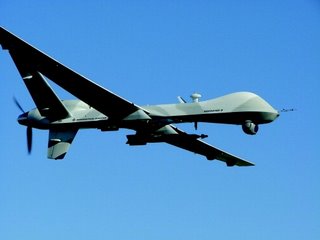 One the attackers had revealed themselves, above them were circling reconnaissance drones (Unmanned Aerial Vehicles, or UAVs) which would relay their co-ordinates to the artillery. Borrowing from a technique pioneered in Viet Nam, these were located in fire-bases away from the action and, within minutes, could bring down highly accurate, targeted fire on the insurgents, bringing instant death.
One the attackers had revealed themselves, above them were circling reconnaissance drones (Unmanned Aerial Vehicles, or UAVs) which would relay their co-ordinates to the artillery. Borrowing from a technique pioneered in Viet Nam, these were located in fire-bases away from the action and, within minutes, could bring down highly accurate, targeted fire on the insurgents, bringing instant death.Additional assets, which could perform the same function as the artillery, were armed UAVs (known as UCAVs) or fighter-bombers stacked in the sky awaiting targets.
 This, in the early stages, is what I though the IDF was doing, but it does not seem as if they had got the phasing and the tactics right. Casualties in tanks and crews, therefore, seem to have been relatively high, without corresponding gains in terrorists killed.
This, in the early stages, is what I though the IDF was doing, but it does not seem as if they had got the phasing and the tactics right. Casualties in tanks and crews, therefore, seem to have been relatively high, without corresponding gains in terrorists killed.And, if this is the ground battle, there is the other element – the Katyusha strikes. In Iraq, the US forces are also prone to such attacks but their greater danger is the "White Van" mortar team. Merging with civilian traffic, these vans can park momentarily and discharge a mortar team to lob a few bombs, which then re-mount and drive off into the traffic, indistinguishable from the hundreds of other vans on the streets.
To counter this, the US has used counter-artillery radars which can locate the firing points of mortars within seconds and, with orbiting UCAVs, fighter bombers or even helicopter patrols, they can return accurate but lethal fire within minutes – or, if preferred, guide ground forces to intercept. Such would have been the expected response from the Israelis so, far from being impressed by their videos showing Katyusha launches, followed by IAF strikes a day or so later, this demonstrated that the capability was lacking.
The propaganda war
Alongside the shooting war, however, there has also been the propaganda war and it is here that the Israelis have proved dismally flat-footed. They are fighting an enemy which, as we have seen with the Qana incident – and many more – is willing to parade the bodies of its dead and, while hiding behind civilians (and even keeping them in harms way) exploits a sympathetic media and an "international community" which is locked into the paradigm that war is the greatest of all evils and any other solution is preferable.
 Hezbolla in particular are aided by the notoriously poor local building standards and their fragile, reinforced concrete-framed buildings which give rise to such spectacular pictures of collapsed buildings after relatively modest impacts. But, in using ordnance such as 500-1000lb bombs, with every attack, the Israelis have been creating propaganda opportunities for their enemies and detractors rather than achieving tactical battlefield gains.
Hezbolla in particular are aided by the notoriously poor local building standards and their fragile, reinforced concrete-framed buildings which give rise to such spectacular pictures of collapsed buildings after relatively modest impacts. But, in using ordnance such as 500-1000lb bombs, with every attack, the Israelis have been creating propaganda opportunities for their enemies and detractors rather than achieving tactical battlefield gains.And, while propaganda in war has always been important, it is more so in current campaigns. In the past, when Israel could conduct "lightning wars", by the time the international community had mobilised to enforce a cease-fire, the IDF had usually achieved its tactical and strategic goals.
But the nature of war has changed. No longer is territorial gain the objective and neither are the opposing armies conveniently lined up in uniform, fighting an open war. The objectives in this new type of war are to bring the enemy to battle and to kill people, to disrupt the hierarchy, the command and communication systems and to destroy materiel.
That process, against the weapons the enemy is prepared to deploy and tactics it uses, takes time. But, even at the glacial speed at which the international community operates, no sooner have the opening phases of combat been rolled out and the pressure is on to bring overt hostilities to a halt. To enable the battlefield objectives to be achieved, therefore, the armed forces also have to win the propaganda war, to give them enough time to complete their tasks.
Collateral damage
In this war, the currency is collateral damage – dead babies and destroyed buildings, images of which have had more effect on the battle than the tanks and guns deployed by the IDF (for a more detailed discussion, see here).
Therein, like the British Army in Iraq, the IDF is using the wrong weapons and tactics. For it too, it is the "wrong kind of war".
Much has been said and written as a result about the limits of military power – much of it nonsense. Of course, final solutions require diplomatic initiatives and societal changes but, when you have any enemy with weapons who is attempting to kill you, there is only one response – to kill them. That means military action and, therefore, war – by whatever name you call it.
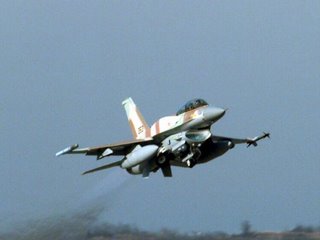 But it is how that war is conducted that makes the difference, and the difference is a matter of technology. The IDF currently is equipped for its previous wars, with superb armoured formations and a fleet of high performance fighter bombers that are capable of executing great slaughter of conventional forces. But they are the wrong weapons for this type of war.
But it is how that war is conducted that makes the difference, and the difference is a matter of technology. The IDF currently is equipped for its previous wars, with superb armoured formations and a fleet of high performance fighter bombers that are capable of executing great slaughter of conventional forces. But they are the wrong weapons for this type of war.On the one hand, in the style of the Fallujah-type operation, they need heavy but highly mobile armour to protect their troops as they provide targets for the enemy, in order to flush them out. And, coming into service is a new generation of artillery with rates of fire that are simply stunning. Capable of firing 40 or more shells a minute, these guns can also lay up to seven shells on a target to arrive simultaneously. Combined with unprecedented accuracy from GPS guidance built into the shells, these can intervene immediately with deadly but highly localised force on any terrorist foolhardy enough to attack.
 For the Katyusha problem, what is needed is not fast jets with limited endurance and, therefore, loiter capability, dropping big bombs. The weapons needed are long-endurance UCAVs and platforms like the AC130 Spectre, with high-precision, small-warhead weapons. One such, in the process of development, is the Viper Strike which, with a 7lb warhead, can kill the occupants of a car without scratching the paintwork of the next car in line, or take out the occupants of a room in a building, without disturbing the neighbours.
For the Katyusha problem, what is needed is not fast jets with limited endurance and, therefore, loiter capability, dropping big bombs. The weapons needed are long-endurance UCAVs and platforms like the AC130 Spectre, with high-precision, small-warhead weapons. One such, in the process of development, is the Viper Strike which, with a 7lb warhead, can kill the occupants of a car without scratching the paintwork of the next car in line, or take out the occupants of a room in a building, without disturbing the neighbours. Suitable platforms, guided by sensor arrays in satellites, UAVs and electronic warfare aircraft, can loiter the battlefield and, when a fleeting target appears, can launch instant but again highly localised death, making terrorist attacks near certain suicide.
Suitable platforms, guided by sensor arrays in satellites, UAVs and electronic warfare aircraft, can loiter the battlefield and, when a fleeting target appears, can launch instant but again highly localised death, making terrorist attacks near certain suicide.Will we learn?
Since Israel is fighting for its very survival, the odds are that it will learn its lessons from the Lebanon campaign, and apply them. There is some confidence that the US forces will do likewise – they, after all, are developing the technology.
One casualty will almost certainly be the multi-billion dollar project called the Future Combat System (FCS). The plan here is to equip forces not with heavier armour, but lightweight, air-portable vehicles, relying for their protection on sophisticated sensors, the rapid exchange of intelligence and stand-off weapons to take out the enemy before he is within range and can do damage. But, when faced with an enemy that has the capability to deliver lethal blows and reveals himself only in the act of firing his weapon (or not at all in the case of an IED or mine), this system is fatally flawed.
Many knowledgeable commentators believe the US will scrap this system but, as a letter in the Sunday Telegraph reminds us, the British Army is still committed to a similar system, a £14 billion fantasy known as the Future Rapid Effects System (FRES), all geared to providing the European Rapid Reaction Force with its "teeth".
Should this go ahead, we will find that not only are the British forces currently equipped for the wrong kind of war, they will perpetuate the error, at enormous cost in money and – eventually – lives. For once, we should look further afield and watch very closely what the Israelis do.
COMMENT THREAD